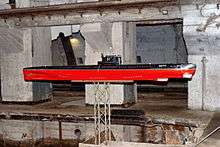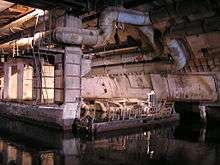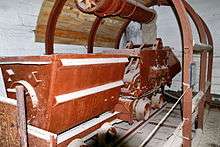Naval museum complex Balaklava




Naval museum complex Balaklava (Ukrainian: Морський музейний комплекс "Балаклава", Russian: Музей холодной войны, "The Cold War Museum", designation K-825) is an underground submarine base in Balaklava, Crimea, Russia/Ukraine[1] (originally known as Object 825 GTS). It was a top-secret military facility during the Cold War, located in Balaklava Bay.
Today it serves as a museum and also houses a museum about the Crimean War.
Description and purpose
The object is built accordingly to withstand a category-I nuclear explosion (protection from a direct hit by a nuclear yield of 100 kt), which includes a combined underground network of water channels with a dry dock, repair shops, warehouses for storage of torpedoes and other weapons. Additionally it could house personnel to protect them from nuclear fallout. Located in the mountain of Tavros, on both sides of which there are exits. If necessary, caisson gates could be used, which seals the entire complex. To exit to the open sea, an exit is provided on the northern side of the mountain. The holes in the rock are neatly covered with camouflage devices and networks.
Object 825 GTS was intended to house, repair and maintain submarines of Projects 613 and 633. The central water channel of the facility, whose length is at 602 meters, could accommodate up to 7 submarines if necessary, and in all channels, up to 14 submarines of different classes. The water channels have depths up to 8 meters, with width ranging from 12 to 22 meters. The total area of all facilities in this base is around 9600 m2, while the total surface area of water is at 5200. Equipment loading in peacetime was carried out on the pier, while watching out for the movements of spy satellites of the possible military adversary. A special tunnel is used for loading equipment into the base in wartime. The entire complex also includes the repair and technical base, codenamed Object 280, designed for storing and maintaining nuclear arsenal. The temperature inside the base is kept around 15 degrees Celsius.
History
In the period after the Second World War, the two superpowers, the USSR and the U.S., stepped up their nuclear arsenal, threatening each other with pre-emptive strikes and retaliatory strikes. It was then when Joseph Stalin gave Lavrentiy Beria (who was responsible at that time for "nuclear projects"), a secret directive: to find a place where they could house submarines for a retaliatory nuclear strike. Several years of research pinpointed the quiet Balaklava as the location, and the city was immediately coded and got merged into the city of Sevastopol as a city district. Balaklava sits on a narrow winding inlet with a width of only 200–400 meters. The small inlet protects the city not only from storms, but also from prying eyes, as it is not visible under any angle from the open sea. Additionally, the site is close to Sevastopol, a major naval base still used by the Russian Navy's Black Sea Fleet.
In 1957 a special construction department coded as No. 528 was created, which handled the construction of underground facilities. The construction of the underground complex lasted for 8 years, from 1953 to 1961. During construction, about 120 thousand tons of rock were removed from the Tavros mountain. To ensure secrecy supplies were transported at night on a barge in the open sea. After closing in 1993, most of the complex is unguarded. In fact, in 2000, the abandoned facility was handed over to the naval forces of the Armed Forces of Ukraine.
However, during the unguarded period from 1993 to 2003, this former base suffered from plundering, with all metal structures scavenged for the metal.[2]
The Sevastopol "Marine Commission" led by Vladimir Stefanovsky proposed the construction of the current museum. The museum would have themed exhibition halls, which were actually repair shops and arsenals, a submarine standing by the underground pier, a tourist center, a cinema room with a chronicle of the time of active military confrontation between the two superpowers, and finally, an underground memorial, which would have immortalized the memories of the deceased submariners who were killed without bullet wounds—in the true cold war in the depths of the ocean.
The 10th anniversary of the museum was celebrated in June 2013.[3] Submarine veterans, former employees of the base as well as representatives from the authorities, armed forces and students attended the ceremony.
The facility was placed under the jurisdiction of Russia and the southern area of the Military History Museum of fortification structures of the Russian Federation in 2014, after the annexation of Crimea.
Restoration
According to press information from March 2014, Russia is considering the possibility of restoring the submarine base in Balaklava.[4]
Address
The base sits at No.22 Tavricheskaya Naberezhnaya street, Balaklava district, Sevastopol, Crimea.
Similar bases
- The underground navy base in Muskö, Sweden, designed for deployment of missile boats and small destroyers.
- Fallout shelters and repair shops in the Bay of Pavlovsk.
- Fallout shelter and submarine repair shops in Vidyaevo.
- The underground submarine base of the Albanian navy in the Adriatic coast, a secret military facility also built during the Cold War. This base was formerly used for basing Soviet submarines, but later went under the control of NATO in 2009.
In popular culture
The 2012 American action film, "Soldiers of Fortune", filmed parts of it near the base.
See also
| Wikimedia Commons has media related to Naval Museum Balaklava. |
- Muskö naval base
- Olavsvern, Norway
- Central Museum of Armed Forces of Ukraine
- Military-Historical Museum of Black Sea Fleet Russia
References
- ↑ This place is located on the Crimean Peninsula, most of which is the subject of a territorial dispute between Russia and Ukraine. According to the political division of Russia, there are federal subjects of the Russian Federation (the Republic of Crimea and the federal city of Sevastopol) located on the peninsula. According to the administrative-territorial division of Ukraine, there are the Ukrainian divisions (the Autonomous Republic of Crimea and the city with special status of Sevastopol) located on the peninsula.
- ↑ Cherkashin, N. "Underground harbor of submarines (Russian)".
- ↑ "Подземный музей отметил юбилей (видео)". meridian.in.ua. Retrieved 2016-11-25.
- ↑ "Подводные лодки в степях Балаклавы". Газета.Ru. Retrieved 2016-11-25.
External links
- Virtual panoramic tour to the museum
- The secret dungeon for submarines
- Novinsky interested submarine base in Crimea
- Balaklava bay - view from space
- visit to the base
- Balaklava Museum of Cold War
Coordinates: 44°29′56″N 33°35′46″E / 44.49889°N 33.59611°E
